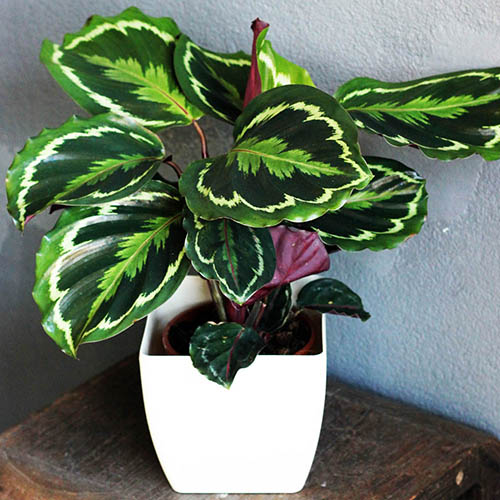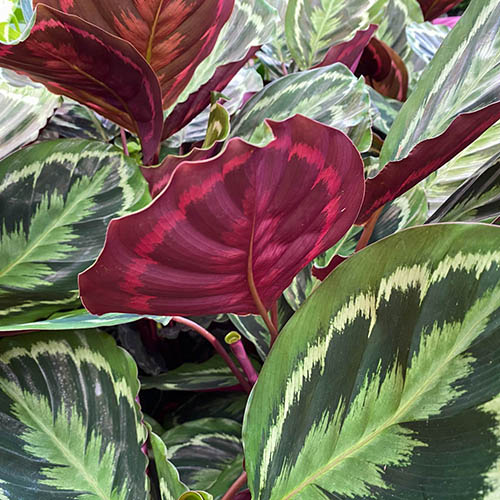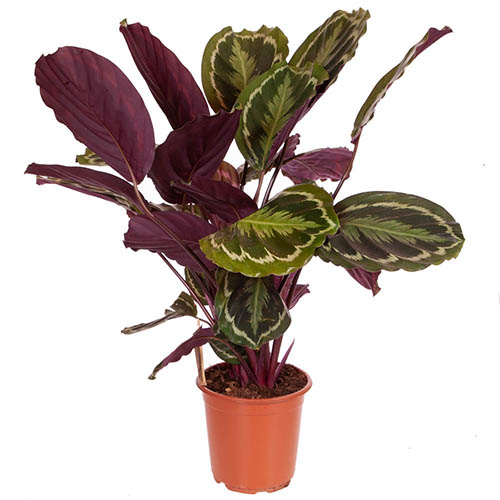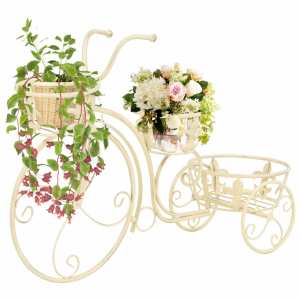Description

Houseplants add a touch of nature to indoor environments. Among their ranks, the Calathea Medallion stands out with its vibrant, ornamental leaves and striking patterns. This tropical plant is not just a pretty face. It’s known for its air-purifying qualities, making it a healthy addition to any living space.
Overview of the Calathea Medallion Houseplant
The Calathea Medallion is a captivating houseplant that is beloved by plant enthusiasts for its stunning foliage and unique characteristics. In this section, we will delve into what makes the Calathea Medallion so special, exploring its features, characteristics, and popular varieties.
What is the Calathea Medallion?
The Calathea Medallion, scientifically known as Calathea veitchiana, is a tropical plant native to the rainforests of Brazil. This plant belongs to the Marantaceae family, which is renowned for its diverse and visually striking foliage.
What sets the Calathea Medallion apart is its large, round leaves that resemble the shape of a medallion, hence its name. The leaves exhibit an exquisite pattern, characterized by deep green hues and intricate, contrasting markings. These markings, often in shades of silver, cream, or purple, resemble delicate brushstrokes, lending the plant an artistic and mesmerizing appearance.
Features and Characteristics of the Calathea Medallion
The Calathea Medallion boasts several features and characteristics that make it a popular choice among plant enthusiasts:
- Brilliant Leaf Patterns: The striking leaf patterns of the Calathea Medallion are a true visual feast. The dark green base colour provides a striking contrast to the intricate silver or cream markings, creating a captivating display.
- Air Purifying Properties: As a part of the Marantaceae family, the Calathea Medallion is renowned for its air-purifying qualities. It actively filters toxins from the air, making it an excellent choice for improving indoor air quality.
- Pet-Friendly: Unlike some houseplants that can be toxic to pets, the Calathea Medallion is considered non-toxic to cats and dogs. This makes it a safe and beautiful addition to any pet-friendly household.
- Interactive Foliage: One of the most fascinating characteristics of the Calathea Medallion is its responsive foliage. The leaves open up during the day to absorb maximum sunlight, and as evening approaches, they elegantly fold up, giving the plant a captivating and dynamic appearance.
Care and Maintenance of the Calathea Medallion
The Calathea Medallion is a stunning houseplant that is known for its vibrant foliage and unique patterns. To keep this tropical beauty thriving in your home, it’s important to provide it with the proper care and maintenance. In this section, we will discuss the various aspects of caring for the Calathea Medallion, including its light and temperature requirements, soil and watering needs, humidity and misting, fertilizing techniques, as well as pruning and propagation methods.
Light and Temperature Requirements
The Calathea Medallion prefers bright, indirect light, making it an ideal choice for areas in your home that receive filtered sunlight. Placing it near a north or east-facing window would be perfect. While it enjoys some indirect sunlight, avoid exposing it to direct sunlight as it can scorch the leaves. When it comes to temperature, the Calathea Medallion thrives in warm and humid conditions. Aim for a temperature range between 65°F and 80°F (18°C to 27°C) to keep your plant happy and healthy.
Soil and Watering Needs
The Calathea Medallion requires well-draining soil to prevent root rot. A good mix can be created by combining equal parts of peat moss, perlite, and potting soil. When it comes to watering, it’s important to keep the soil consistently moist but not waterlogged. Avoid letting the plant sit in standing water, as this can lead to root rot. Check the top inch of soil, and if it feels dry, it’s time to water your Calathea Medallion. Remember to use room temperature water to avoid shocking the plant’s roots.
Humidity and Misting
Being native to tropical regions, the Calathea Medallion thrives in high humidity. To create a humid environment for your plant, you can place a tray filled with water near it or use a humidifier. Misting the leaves regularly with room temperature water also helps to increase humidity levels. This not only keeps the plant happy but can also prevent issues like brown leaf tips caused by low humidity. Aim for a humidity level between 50% and 60% to ensure optimal growth.
Fertilizing the Calathea Medallion
To provide your Calathea Medallion with the necessary nutrients, it’s important to fertilize it regularly during the growing season. A balanced, water-soluble fertilizer with an NPK ratio of 10-10-10 or 14-14-14 is suitable for this plant. Dilute the fertilizer to half the recommended strength and apply it every two to four weeks. However, avoid fertilizing during the winter months when the plant is in its dormant phase. Always follow the manufacturer’s instructions for best results.
Pruning and Propagation Techniques
Pruning the Calathea Medallion is not necessary for its health, but it can help to maintain its shape and remove any yellow or damaged leaves. Use clean and sharp pruning shears to make clean cuts and avoid tearing the leaves. Additionally, if you wish to propagate your Calathea Medallion, you can do so through division. Gently remove the plant from its pot and separate the root clumps with your hands or a clean knife. Ensure that each division has a few healthy leaves and roots before planting them in separate pots.
By following these care and maintenance guidelines, you can ensure that your Calathea Medallion thrives and remains a stunning addition to your indoor space. Remember to observe your plant closely and adjust its care as needed to provide it with the best possible growing conditions.
Common Pests and Diseases of the Calathea Medallion
The Calathea Medallion is a beautiful houseplant known for its striking foliage and vibrant patterns. Like any other plant, it is susceptible to pests and diseases that can hinder its growth and overall health. In this section, we will explore the common pests and diseases that can affect the Calathea Medallion and discuss how to identify and treat them effectively.
Identifying and Treating Pests
Pests can be a nuisance for any plant owner, and the Calathea Medallion is no exception. Here are some common pests that may infest your plant and how to deal with them:
- Spider Mites: These tiny arachnids may appear as specks or webs on the underside of the leaves. They feed on the plant’s sap, causing yellow spots and stunted growth. To get rid of spider mites, gently wipe the leaves with a damp cloth and regularly mist the plant to increase humidity.
- Mealybugs: Mealybugs are small, cotton-like insects that cluster on the leaves and stems of the Calathea Medallion. They suck the sap from the plant, leading to a weakened appearance. To eliminate mealybugs, you can use a cotton swab dipped in rubbing alcohol to remove them manually. Alternatively, you can try a horticultural oil spray to suffocate them.
- Fungus Gnats: These tiny flying insects are attracted to damp soil and can cause damage to the roots of your Calathea Medallion. To combat fungus gnats, allow the soil to dry out between watering’s and avoid overwatering. You can also use yellow sticky traps to catch the adult gnats and prevent them from reproducing.
Dealing with Common Diseases
In addition to pests, the Calathea Medallion can also be susceptible to certain diseases. Here are a few common diseases and how to manage them effectively:
- Root Rot: Overwatering or poorly draining soil can lead to root rot in the Calathea Medallion. This fungal disease causes the roots to decay, resulting in wilting leaves and stunted growth. To prevent root rot, ensure that the plant is potted in well-draining soil and avoid overwatering. If root rot has already occurred, it may be necessary to repot the plant in fresh, dry soil and trim away any affected roots.
- Leaf Spot: Leaf spot is a fungal disease that manifests as brown or black spots on the leaves of the Calathea Medallion. It is often caused by overwatering, poor air circulation, or high humidity. To control leaf spot, remove affected leaves and improve air circulation around the plant. Avoid wetting the foliage when watering and consider using a fungicidal spray if the problem persists.
- Powdery Mildew: Powdery mildew appears as a white, powdery coating on the leaves of the Calathea Medallion. This fungal disease thrives in humid conditions and can weaken the plant if left untreated. To combat powdery mildew, increase air circulation around the plant, avoid overhead watering, and apply a fungicidal spray as necessary.
By being vigilant and proactive, you can keep your Calathea Medallion healthy and free from pests and diseases. Regularly inspect your plant for any signs of infestation or disease, and take appropriate measures to address the issue promptly. Remember, a healthy and thriving Calathea Medallion will reward you with its gorgeous foliage and vibrant presence in your home.
Troubleshooting Common Calathea Medallion Issues
Calathea Medallion is a stunning houseplant with its vibrant, patterned leaves that add a touch of elegance to any indoor space. However, like any plant, it may encounter some issues that can cause concern for its owners. In this section, we will discuss three common problems that you may encounter with your Calathea Medallion: brown leaf edges or tips, yellowing leaves, and curling or wilting leaves.
Brown Leaf Edges or Tips
One of the most common issues Calathea Medallion owners face is the browning of leaf edges or tips. This can be caused by several factors, including low humidity levels, overwatering, or excessive exposure to direct sunlight.
To address this problem, ensure that your Calathea Medallion is placed in a location with indirect, filtered light. Direct sunlight can scorch the leaves and lead to browning. Additionally, it is important to maintain a humidity level of around 60% to 70%. You can achieve this by using a humidifier, placing a tray of water near the plant, or misting the leaves regularly.
Overwatering is another common cause of browning leaf edges. Make sure to allow the top inch of soil to dry out before watering your Calathea Medallion again. It is important to strike a balance and avoid both underwatering and overwatering.
Yellowing Leaves
Another issue that Calathea Medallion owners may encounter is the appearance of yellowing leaves. This can be a sign of several problems, including overwatering, nutrient deficiencies, or exposure to cold drafts.
To address yellowing leaves, ensure that you are not overwatering your plant. Calathea Medallions prefer slightly moist soil, but excess water can lead to root rot and yellowing leaves. Also, consider fertilizing your plant regularly with a balanced houseplant fertilizer to ensure it receives adequate nutrients.
Cold drafts can also cause yellowing leaves. Make sure to keep your Calathea Medallion away from drafty areas, such as open windows or air conditioning vents.
Curling or Wilting Leaves
If you notice that the leaves of your Calathea Medallion are curling or wilting, it could be a sign of underwatering, low humidity, or temperature extremes.
To address curling or wilting leaves, make sure to water your plant adequately. Calathea Medallions prefer slightly moist soil, so ensure that the top inch of soil does not dry out completely between watering.
Maintaining a humidity level of around 60% to 70% is crucial for the health of your Calathea Medallion. Consider using a humidifier or placing a tray of water near the plant to increase humidity levels.
Extreme temperatures can also cause curling or wilting leaves. Calathea Medallions thrive in temperatures between 18°C to 24°C (64°F to 75°F). Avoid exposing your plant to cold drafts or sudden temperature fluctuations.
By addressing these common issues, you can help your Calathea Medallion thrive and maintain its stunning appearance. Remember to observe your plant closely and make adjustments based on its specific needs. With proper care, your Calathea Medallion will continue to be a beautiful addition to your indoor space.
Decorating with the Calathea Medallion
The Calathea Medallion houseplant is not only a beautiful addition to any indoor space but also a versatile plant that can be used to enhance your home décor in various ways. In this section, we will explore the best indoor locations to display your Calathea Medallion, as well as the complementary plants and décor that can elevate its visual appeal.
Best Indoor Locations
When it comes to showcasing your Calathea Medallion, choosing the right location is crucial. Here are some indoor areas where this stunning plant thrives:
- Living Room: Place your Calathea Medallion in a well-lit corner of your living room, where it can add a touch of elegance and vibrancy to the space. Its striking foliage, with its distinctive patterns and colours, will surely catch the eye of your visitors.
- Home Office: Adding a Calathea Medallion to your home office can create a calming and inspiring atmosphere. Its lush green leaves can help reduce stress and enhance productivity, making it an ideal companion during long working hours.
- Bedroom: Bring a serene and tropical feel to your bedroom by incorporating a Calathea Medallion. Its air-purifying properties can improve the quality of your sleep, while its visually appealing foliage provides a soothing ambiance.
Frequently Asked Questions about the Calathea Medallion
The Calathea Medallion is a stunning houseplant known for its vibrant foliage and unique patterns. As with any plant, caring for it properly is essential to ensure its health and beauty. In this section, we will address some frequently asked questions about the Calathea Medallion to help you become a confident plant parent.
How often should I water my Calathea Medallion?
Watering is an important aspect of Calathea Medallion care, and finding the right balance is crucial. Overwatering or underwatering can lead to various issues, so it’s important to pay attention to your plant’s needs.
Ideally, you should water your Calathea Medallion when the top inch of soil feels slightly dry. However, it’s important to note that different environmental factors, such as temperature and humidity, can affect the watering frequency. During warmer months, you may need to water more frequently, while in cooler months, you may need to adjust the watering schedule accordingly.
To water your Calathea Medallion, thoroughly soak the soil until water drains out of the drainage holes. Allow any excess water to drain away, as waterlogged roots can lead to root rot. Remember, it’s always better to underwater slightly than overwater.
Can the Calathea Medallion tolerate low light conditions?
While the Calathea Medallion prefers bright, indirect light, it can tolerate lower light conditions to some extent. However, placing it in areas with low light for extended periods can negatively impact its growth and overall health.
In low light conditions, the Calathea Medallion’s growth may slow down, and its stunning leaf patterns may fade. If you have to place your plant in a low light area, consider supplementing with artificial lighting, such as a grow light, to provide the necessary light energy for photosynthesis.
Remember to observe your plant closely and make adjustments as needed. If you notice signs of stress, such as leggy growth or pale leaves, it’s a sign that your Calathea Medallion may not be getting enough light.
What are the signs of overwatering or underwatering?
Overwatering and underwatering can both have detrimental effects on your Calathea Medallion. It’s important to be able to recognize the signs to address any watering issues promptly.
Signs of overwatering may include yellowing or wilting leaves, mushy or rotten roots, or the presence of fungus gnats. If you suspect overwatering, allow the soil to dry out before watering again and ensure proper drainage.
On the other hand, underwatering can cause the Calathea Medallion’s leaves to curl, dry out, or become brown and crispy at the edges. If you notice these signs, it’s crucial to increase watering frequency and ensure the soil is adequately moistened.
Remember, every plant is unique, and environmental factors can vary. It’s essential to observe your Calathea Medallion closely, check the soil moisture regularly, and adjust your watering routine accordingly.
By understanding the watering needs and light requirements of your Calathea Medallion, you can provide optimal care and create a thriving environment for this stunning houseplant.
The Calathea Medallion houseplant is a stunning addition to any indoor space. Its vibrant foliage and unique patterns make it a sought-after choice for plant enthusiasts. Not only does it add beauty to your home, but it also offers several benefits. The Calathea Medallion is known for its air-purifying qualities, improving the overall air quality in your living environment. Additionally, this plant is relatively low-maintenance, making it an ideal choice for those who may not have a green thumb. By following a few simple care tips, such as providing indirect light and regular watering, you can enjoy the beauty of the Calathea Medallion for years to come. So, if you’re looking to elevate the aesthetic appeal of your home and improve the air quality, the Calathea Medallion houseplant is definitely worth considering.




Reviews
There are no reviews yet.